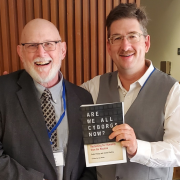Twenty-five years ago, Vigen Guroian published Tending the Heart of Virtue: How Classic Stories Awaken a Child’s Moral Imagination (Oxford University Press). Since then, the book has become a minor classic in the homeschooling community and classical schools. It isn’t hard to understand why: not only does Dr. Guroian defend the need for fairy tales and fantasy literature, but he walks through numerous stories showing their power to awaken the moral sense. Now Oxford University Press has brought out a new and expanded edition of Dr. Guroian’s classic.
I confess I tend to be skeptical of Christian authors who write books about fairy tales and fantasy literature, especially those who would tell me what I’m supposed to get out of a story. In my experience, this often amounts to either instrumentalizing the text for pragmatic ends or imposing a Christian meaning externally onto the text. It’s easy enough to object to the instrumentalizing of literature by woke critics (the types of people who would make “The Ugly Duckling” about minority victimhood or reduce “Cinderella” to a tract on self-actualization), yet Christians have their own version of this same instrumentalization, with endless publications on such topics as how to find God in The Lord of the Rings or how to interpret Homer Christianly. While such approaches are not necessarily wrong, they often come with a subtext that good art lacks intrinsic value and only becomes valuable as a means to other ends.
When I first picked up Tending the Heart of Virtue, I was prepared to be put off. A book about cultivating morality through classic stories seemed like a recipe for destroying the stories with didactic moralizing. “Not another book that treats stories simply as a resource,” I thought.
I was delighted to be wrong, and in my recent review of Guroian’s book for Touchstone Magazine, I explain why:
Dr. Guroian does see classic stories as useful, insofar as they awaken the moral imagination; yet they do this on their own terms, without our needing to impose meaning from outside. Where he offers commentary, the purpose is gently to draw out elements in the stories that might be easy for moderns to overlook, thus enabling the stories to speak for themselves in all their wonder and glory. Furthermore, Dr. Guroian sees classic stories as a challenge to a didactic, agenda-driven approach to ethics that so often characterizes moral instruction. As he writes, “Not didacticism, but rather the narrative, the dramatic action, makes the fairy tales meaningful. Narrative supplies the imagination with important symbolic information about the shape of our world and appropriate responses to its inhabitants.
To read my entire Touchstone review, click on the link below:


